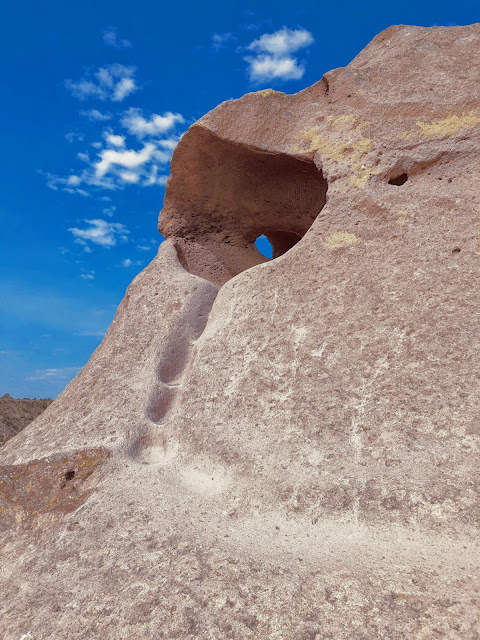It was early September, the hottest day of the year, when we walked out onto Otowi Mesa, a finger of a ridge that points east from Los Alamos toward the Rio Grande Rift Valley. You can see the valley in the background where a thin blue layer of smoke from forest fires was settling and the temperature was hovering around 100 – it was about 10 degrees cooler up here.
Zooming in on the smoke settling in the valley: the mesas in the foreground are where thick layers of volcanic tuff that form the Pajarito Plateau have resisted more than one million years of erosion, which carved down the land surrounding them, forming canyons. On the horizon, the Sangre de Cristo mountain range is the east edge of the Rio Grande Rift valley.
Below here, Otowi mesa becomes a narrow spine of rock extending off the left side of this photo for several miles.
The same view of Otowi Mesa five months later as the sun was setting on a snowy February day.
We literally followed in the footsteps of Ancestral Puebloans, whose feet carved these steps in the soft volcanic tuff rock. This rock layer is the remnant of an immense volcanic eruption that created the Valles Caldera, which rises above this mesa to the west.
An ancient pathway carved by the feet of Ancestral Puebloans in this steep section of rock.
Walking on the narrow spine of Otowi Mesa.
And again, five months later on a winter's eve.
Looking back west to the developed part of Otowi Mesa, where we began our hike, in a suburb of Los Alamos. The rim of the Valles Caldera, aka the Jemez Mountains, is on the horizon.
The winter view . . .
This little grotto had an ancient path with footsteps leading up to it.
A geometric grid of marks was scratched into the top of the grotto. They looked to me like petroglyphs typical of the Archaic Period, which lasted from 10,000 to 3,000 years ago.
Taking a photo through that eye, from the top.
Gazing down through the eye . . .
A branch of the footpath is carved onto narrow ledges that descend from the ridge into Pueblo Canyon, where the Otowi Pueblo was located.
Looking back up that path.
The path leads to the floor of the valley, where Otowi Pueblo was located on the green ridge in shadow. The field in the foreground was probably a wetland and source of plentiful running water (it looks pretty dry today). Behind it on the left, the wall of Otowi mesa forms the north edge of Pueblo Canyon.
Otowi Pueblo consisted of five large buildings with stepped-back terraces that rose to a height of two to four stories, and contained as many as 700 rooms plus 10 large circular sunken rooms (often referred to as kivas). The Tewa people lived in this area between the years 1150 and 1550, before moving down toward the Rio Grande River valley when the climate got drier. Today their ancestors live in the San Ildefenso Pueblo, which owns the land under the Otowi Pueblo site.
Although the site of Otowi Pueblo is fenced off by the San Ildenfenso Pueblo, we were able to walk on a ridge to the west that had been the site of about eight small pueblo houses. We saw an abundance of ancient pottery sherds (like this one) and chert flakes from the making of stone tools.
I was delighted to spot this beautiful piece of pottery that is about ten times larger than pieces I typically come across. I left it where I found it (as I do for all ancient artifacts; actually I hid this one a little better to try and prevent it from being carried off by a collector).
Here is the reverse side of the pottery piece. In the corner on the left is what appears to me to be a "kill hole" – a hole that was intentionally drilled in a pot when it was no longer going to be used, or may have been part of honoring a deceased person. Rina Swentzell – a native of the Santa Clara Pueblo, who was among the first Pueblo women to receive a Ph.D. and was a noted historian, teacher, architect, potter, and activist for justice – has said this signifies that all objects are alive and share the breath that flows through the universe. Thus, pots are punctured or symbolically “killed” to allow this breath or spirit to escape back into the cosmos.
9/6/2020 with Diana Clanin and 1/31/2021 with Tiffany Montavon
























Comments
Post a Comment